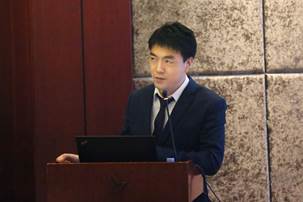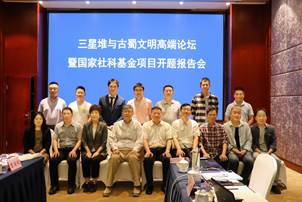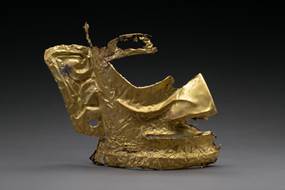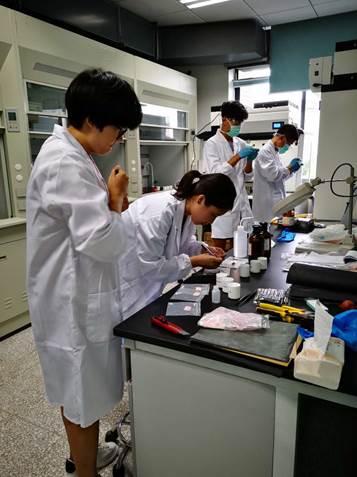I. Proposal and academic conferences
On May 28, 2022, the proposal conference for the major 2022 National Social Science Foundation project “Research on Sanxingdui culture and the Chinese Civilization” was held at Xiangyu Hotel in Chengdu, Sichuan Province (Figure 1). The chief expert on the project was Professor Haichao Li of the School of History and Cultures (Tourism School, School of Archaeology and Museology) of Sichuan University. Professor Qilin Fu, director of the Social Science Department of Sichuan University, presided over the conference. Leye Yao, vice president of Sichuan University, Jing Zhao, director of the Planning Office of Sichuan Provincial Social Science Federation, and Wei Huo, distinguished professor of Sichuan University, attended the conference and delivered speeches. Some other experts from Sichuan University also attended the conference as an expert team together with Prof. Huo. Conference attendees also included over 30 researchers from the Sichuan Provincial Institute of Cultural Relics and Archaeology.
Professor Li presented the project proposal (Figure 6), which focused on the content and ongoing work of the project. The presentation included a detailed introduction of the research objectives, research methods, and the project structure. Later, Professor Hongliang Lu, a member of the expert team, presided over the expert team’s deliberations (Figure 7). The participating experts and scholars highly appreciated the significance and value of the project. They deemed the project reasonably structured, innovative in theory and methodology, and demonstrated world-leading research levels. Furthermore, they engaged in in-depth discussion over the research content, feasibility analysis, challenges, and innovations of the project. Finally, Professor Lu delivered a concluding speech.

Professor Haichao Li presented the proposal
The “High-end Forum on Sanxingdui and the Ancient Shu Civilization” continued into the afternoon. Ten scholars delivered speeches at the conference, including Wei Huo, distinguished professor of Sichuan University, Hua Sun, professor of the School of Archaeology and Museology of Peking University, and Jinsong Shi, deputy director and researcher of the Institute of Archaeology, the Chinese Academy of Social Sciences. The participating scholars addressed multiple research areas from various aspects. These included the following: the significance of the archaeology of Sanxingdui in terms of cultural history; the art of Bashu; the cultural and technological aspects of Sanxingdui Ruin Site; the characteristics of the countryside at Sanxingdui; the concept of “Sanxingdui–Jinsha culture”; the similarities and differences between the ritual remains found at the Sanxingdui and Jinsha sites; the spatial and temporal scopes of the Sanxingdui culture; the nature of the remains of the Yufu site (Phase Three); the casting process of the bronze found in the sacrificial pits at the Sanxingdui site; the bronze artifacts of the Warring States period in the Sichuan basin. The conference presented a significant opportunity for attendees to exchange views and generate fresh insights, advancing the study on Sanxingdui and the ancient Shu civilization.

Group photo of offline attendees
II. Fieldwork
Field excavations have been completed at K3 (sacrificial pits at the Sanxingdui site), K4, K5, and K6 as of May 2022. Further, the fieldwork have entered the finishing stage at K3 and K4. Moreover, archaeological laboratory cleanup was conducted at K5 and K6, and artifact extraction was about to be completed at K7 and K8.
The School of Archaeology and Culture of Sichuan University was responsible for the cleanup of pits K5, K6, and K7. Although K5 is the smallest of all pits, numerous gold wares were evacuated, including the largest gold mask ever found, as well as bird-shaped gold ornaments and ax-shaped gold wares. The first wooden box was found at K6 at the Sanxingdui site, which is known to contain silk in it according to scientific analysis. A stunning tortoise-backed lattice-shaped vessel was unearthed from K7, which is unprecedented and breathtaking.
Numerous artifacts of copper, bone, gold, and other textures were cleaned during this fieldwork, and several important archaeological materials were obtained, which supplemented and improved the archaeological materials for research on the sacrificial pits at the Sanxingdui site. They present a three-dimensional image of the Sanxingdui culture and is of far-reaching significance for further research on the Sanxingdui culture and other issues.

Gold mask excavated from K5

Members of the project team cleaning artifacts excavated from K7
III. Scientific and technological aspects of archaeology
The project team utilized microscopic observation, micro-CT, scanning electron energy dispersive spectroscopy, Raman spectroscopy, X diffraction, X-ray flaw detection, and other analytical techniques to analyze and study the composition and structure of the body and rust products of some typical bronze, jade, and gold wares and the casting process. They gained a preliminary understanding of the composition of the body of the bronze and gold wares excavated from the sacrificial pits. Microscopic observation suggests that the hammering process was applied in making gold masks, ornaments, and other gold wares. It also revealed sheet-cutting, thread-cutting, and other cutting processes and pipe drilling, solid drilling, and other drilling processes. It found that thread-hollowing, emery, and other carving processes were utilized in making jade wares.
Ultra-deep field microscopy, scanning electron microscopy, infrared spectroscopy, Raman spectroscopy, CT, carbon and nitrogen isotope mass spectrometry, and other techniques were utilized to conduct systematic analysis and testing from the perspectives of appearance and morphology, microstructure, and material composition. Silk residues were found on over 30 artifacts excavated from pits No. 3, 4, 7, and 8, which were mostly plain weave and partly oblique weave. Moreover, silk protein signals were detected in the soil sample in the bottom of the wooden box found at pit No. 6 using electrochemical immunosensor technology. The discovery filled a gap in the silk archaeology in the Bashu region during the Yin-Shang period.
Additionally, the findings of ongoing multidisciplinary research work will be revealed in succession. Such work includes the effects of surface burnishing on ivory, the analysis of jade impregnation, jade material, and micro-traces, the testing of gold leaf composition, the metallographic analysis of bronze wares, and the analysis of the ancient DNA of ivory.

Subject members conducting experiments

